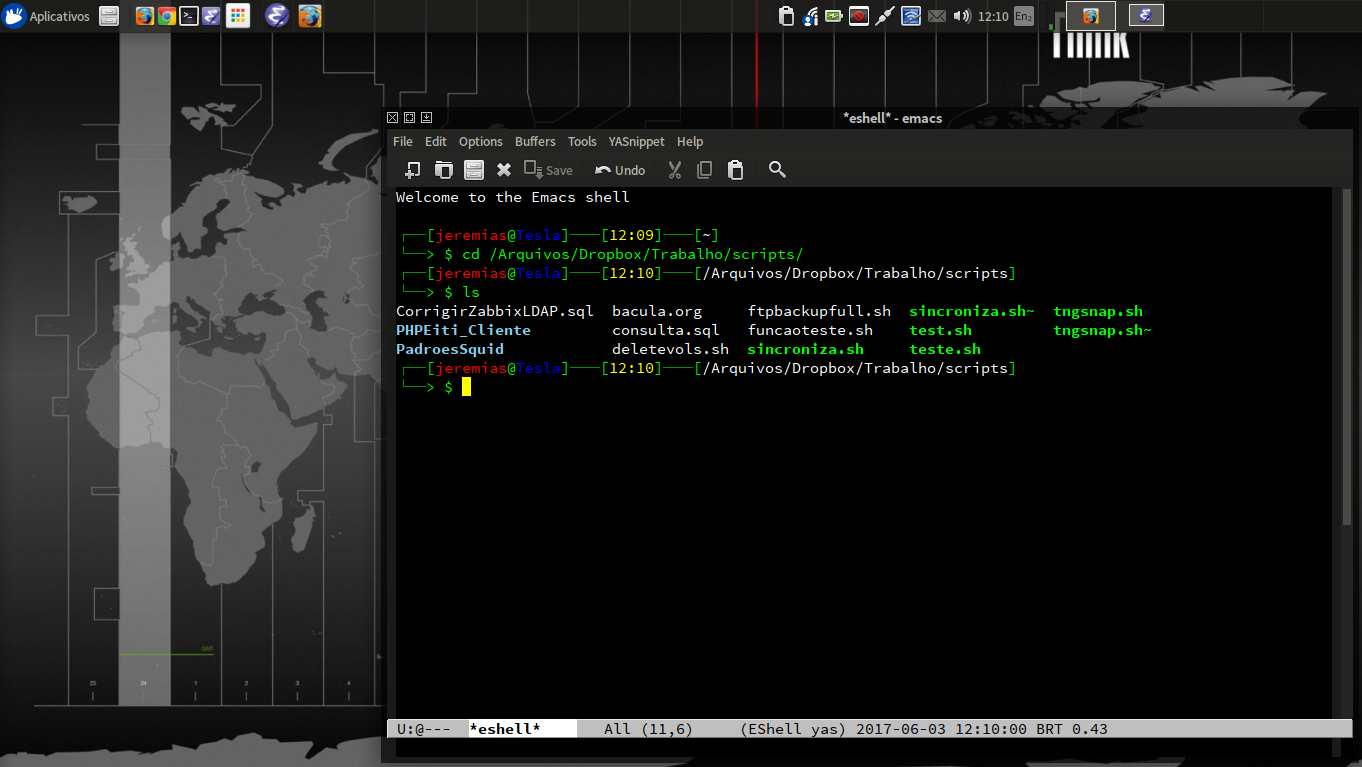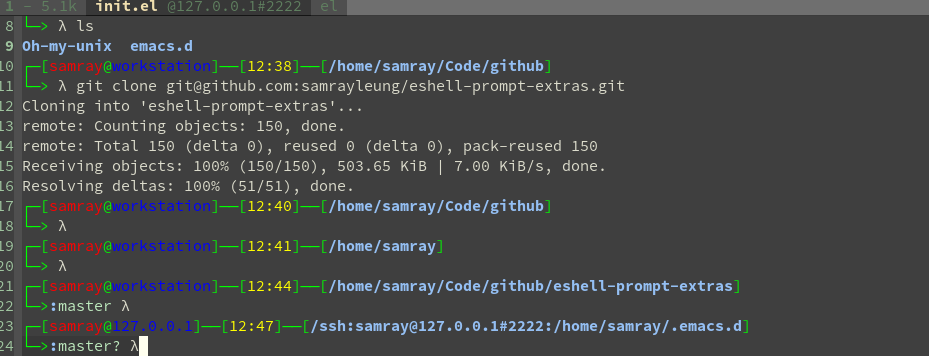1 发现帅气的提示符
近日,笔者在浏览 Reddit 的时候,发现了一位 Emacs 用户把他的 Eshell 提示符修改得很帅,如图:
 本着拿来主义的想法,我就直接把这位小哥的代码添加到了我的配置文件里面:
本着拿来主义的想法,我就直接把这位小哥的代码添加到了我的配置文件里面:
(setq eshell-prompt-function
(lambda ()
(concat
(propertize "┌─[" 'face `(:foreground "green"))
(propertize (user-login-name) 'face `(:foreground "red"))
(propertize "@" 'face `(:foreground "green"))
(propertize (system-name) 'face `(:foreground "blue"))
(propertize "]──[" 'face `(:foreground "green"))
(propertize (format-time-string "%H:%M" (current-time)) 'face `(:foreground "yellow"))
(propertize "]──[" 'face `(:foreground "green"))
(propertize (concat (eshell/pwd)) 'face `(:foreground "white"))
(propertize "]\n" 'face `(:foreground "green"))
(propertize "└─>" 'face `(:foreground "green"))
(propertize (if (= (user-uid) 0) " # " " $ ") 'face `(:foreground "green"))
)))
效果自然是很 sexy.
2 与原有提示符冲突
但是我原来使用的 eshell-prompt-extra 的效果就被覆盖了。而 eshell_prompt_extra 可以提供的额外信息非常多,包括:git, python virtualenv, 以及远程登录时的主机信息,如图:

如果用上这个 sexy 的提示符,eshell-extra-prompt 的额外的信息就不能显示,感觉好亏:(
鱼和熊掌我都想要,似乎太贪心了?怎么办,自己去修改 eshell_prompt_extra 的源码 :).
3 折腾源码
eshell_prompt_extra 这个包注释加上全部代码也只是 400 行,代码也写得很清晰. 其中大部份是辅助函数,而 Eshell 的提示符效果是通过两个 eshell-theme 函数来实现的。use-package 的配置:
(use-package eshell-prompt-extras
:ensure t
:load-path "~/Code/github/eshell-prompt-extras"
:config (progn
(with-eval-after-load "esh-opt"
(use-package virtualenvwrapper :ensure t)
(venv-initialize-eshell)
(autoload 'epe-theme-lambda "eshell-prompt-extras")
(setq eshell-highlight-prompt nil
eshell-prompt-function 'epe-theme-lambda))
))
而 epe-theme-lambda 的代码如下:
(defun epe-theme-lambda ()
"A eshell-prompt lambda theme."
(setq eshell-prompt-regexp "^[^#\nλ]*[#λ] ")
(concat
(when (epe-remote-p)
(epe-colorize-with-face
(concat (epe-remote-user) "@" (epe-remote-host) " ")
'epe-remote-face))
(when epe-show-python-info
(when (fboundp 'epe-venv-p)
(when (and (epe-venv-p) venv-current-name)
(epe-colorize-with-face
(concat "(" venv-current-name ") ") 'epe-venv-face))))
(let ((f (cond ((eq epe-path-style 'fish) 'epe-fish-path)
((eq epe-path-style 'single) 'epe-abbrev-dir-name)
((eq epe-path-style 'full) 'abbreviate-file-name))))
(epe-colorize-with-face (funcall f (eshell/pwd)) 'epe-dir-face))
(when (epe-git-p)
(concat
(epe-colorize-with-face ":" 'epe-dir-face)
(epe-colorize-with-face
(concat (epe-git-branch)
(epe-git-dirty)
(epe-git-untracked)
(let ((unpushed (epe-git-unpushed-number)))
(unless (= unpushed 0)
(concat ":" (number-to-string unpushed)))))
'epe-git-face)))
(epe-colorize-with-face " λ" 'epe-symbol-face)
(epe-colorize-with-face (if (= (user-uid) 0) "#" "")
'epe-sudo-symbol-face)
" "))
代码主要逻辑是调用之前定义的辅助函数,判断是否需要显示 git, python, 远程主机等信息,然后对相应的提示符进行拼接。
而其中出现得比较频繁的 epe-colorize-with-face 就是作者定义的一个宏(macro), 用来显示字符串以及对应的 face(其实就是不同的颜色啦). 看懂了代码就好办了,现在就可以自己添加一个 Eshell 主题。
3.1 定义所需的 face
因为我需要显示的 face(颜色), eshell-extra-prompt 并没有定义,所以就只好自己动手啦:
(defface epe-pipeline-delimiter-face
'((t :foreground "green"))
"Face for pipeline theme delimiter."
:group 'epe)
(defface epe-pipeline-user-face
'((t :foreground "red"))
"Face for user in pipeline theme."
:group 'epe)
(defface epe-pipeline-host-face
'((t :foreground "blue"))
"Face for host in pipeline theme."
:group 'epe)
(defface epe-pipeline-time-face
'((t :foreground "yellow"))
"Face for time in pipeline theme."
:group 'epe)
然后就是按着原有的 Eshell 提示符来组装一个新的 Eshell 主题了,然后把这个主题定义成 pipeline (其实是我自己也没想出比较新颖的名字啦):
(defun epe-theme-pipeline ()
"A eshell-prompt theme with full path, smiliar to oh-my-zsh theme."
(setq eshell-prompt-regexp "^[^#\nλ]* λ[#]* ")
(concat
(if (epe-remote-p)
(progn
(concat
(epe-colorize-with-face "┌─[" 'epe-pipeline-delimiter-face)
(epe-colorize-with-face (epe-remote-user) 'epe-pipeline-user-face)
(epe-colorize-with-face "@" 'epe-pipeline-delimiter-face)
(epe-colorize-with-face (epe-remote-host) 'epe-pipeline-host-face))
)
(progn
(concat
(epe-colorize-with-face "┌─[" 'epe-pipeline-delimiter-face)
(epe-colorize-with-face (user-login-name) 'epe-pipeline-user-face)
(epe-colorize-with-face "@" 'epe-pipeline-delimiter-face)
(epe-colorize-with-face (system-name) 'epe-pipeline-host-face)))
)
(concat
(epe-colorize-with-face "]──[" 'epe-pipeline-delimiter-face)
(epe-colorize-with-face (format-time-string "%H:%M" (current-time))
'epe-pipeline-time-face)
(epe-colorize-with-face "]──[" 'epe-pipeline-delimiter-face)
(epe-colorize-with-face (concat (eshell/pwd)) 'epe-dir-face)
(epe-colorize-with-face "]\n" 'epe-pipeline-delimiter-face)
(epe-colorize-with-face "└─>" 'epe-pipeline-delimiter-face)
)
(when epe-show-python-info
(when (fboundp 'epe-venv-p)
(when (and (epe-venv-p) venv-current-name)
(epe-colorize-with-face
(concat "(" venv-current-name ") ") 'epe-venv-face))))
(when (epe-git-p)
(concat
(epe-colorize-with-face ":" 'epe-dir-face)
(epe-colorize-with-face
(concat (epe-git-branch)
(epe-git-dirty)
(epe-git-untracked)
(let ((unpushed (epe-git-unpushed-number)))
(unless (= unpushed 0)
(concat ":" (number-to-string unpushed)))))
'epe-git-face)))
(epe-colorize-with-face " λ" 'epe-symbol-face)
(epe-colorize-with-face (if (= (user-uid) 0) "#" "")
'epe-sudo-symbol-face)
" "))
4 总结
这样一个新的 Eshell 主题就完工了,然后我给 eshell-extra-prompt 发了一个Pull Request, 最终效果如下:

Enjoy Emacs, Enjor Tweaking :)